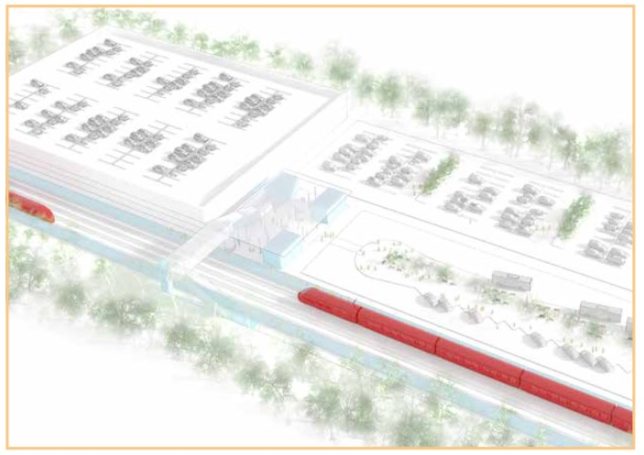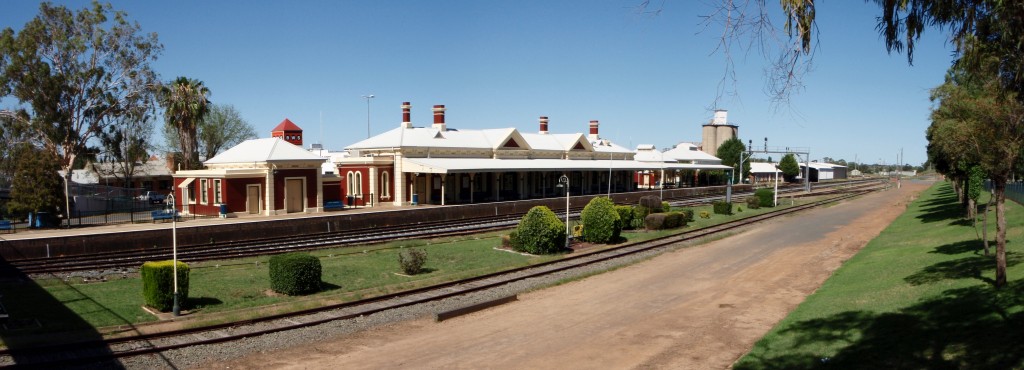AECOM13 manages to spend $7.1 billion on new and unnecessarily expensive stations (indeed, compare this cost to the actual track, at only $6.6 billion). This post demonstrates that this cost is excessive by comparison to contemporary examples, and proposes a more realistic and affordable estimate.
The Hot Rails strategy, in line with the overall strategy of re-using the existing infrastructure and facilitating regional development, is to prioritise access to existing country stations wherever this is practical. The benefit of this is two-fold; obviously it is far cheaper than building greenfield sites, but it also reduces dependence on cars and other supporting travel modes where existing stations are located within town centres, rather than brand new sites out on the periphery of town.
Regional stations
AECOM13 assumes regional stations will cost $70 million each. Unfortunately the report itself does not describe these proposed stations in any great detail, only including a very basic concept image (above) and not even any estimate of floor area. However, we can estimate their assumed floor area from the estimated power consumption of 500MWh per year. Based on AECOM’s assumption of .056MWh per square metre, it implies the regional stations are (500/.056) = almost 9,000 square metres. I don’t know about you, but that little glass-roofed, open-air station building in the concept image doesn’t look like two-and-a-bit acres of floor area.
At any rate, the idea that the railway needs sleek, modern, architecturally designed wonders is a large part of the problem. Hot Rails proposes to greatly reduce the cost of stations by utilising less extravagant designs, and re-using existing stations wherever possible.
OK – what’s the bare minimum we need at a regional station?
- One platform for each line (ie dual track needs 2 platforms) – say, $250,000 per platform.
- A building containing amenities, ticket sales and station services – say, $1,000,000
- Shelter on each platform – but not necessarily over the entire length – say, $250,000
- Pedestrian over- or under-pass to access both platforms – say, $500,000
- Steel-pallisade security fencing around entire station precinct – say, 1km of fence, = $100,000
- A halfway-decent paint job – say, $150,000
- TOTAL – $2.5m for a basic, greenfield station.
Additional items might include:
- Upgraded parking facilities (ie, sealed carpark)
- Upgraded lighting / security cameras
- Passenger gates to ensure only ticketed passengers access platform (depends on ticketing strategy)
Many of the proposed Hot Rails stations are at existing historical town stations that have community groups dedicated to their upkeep, so that should be able to offset some of the cost, especially for things like painting and minor carpentry.
Recent examples
It is difficult to find accurate estimates of cost, since as with so many things in this study, the actual cost is so highly dependent on the specific details of a project. However we can gain some broad estimates by looking at some real-world examples.
- Williams Landing railway station on the Melbourne metro network was completed in 2013 at a cost of $86 million. This greenfield and architecturally extravagant station, including 2 platforms and 3 tracks, can be considered an upper limit for any reasonable circumstances.
- Wayville Railway Station in Adelaide was built at a cost of $16.5m in 2014 to service the Royal Adelaide Showgrounds. Its 3 plaforms are completely undercover, and while not as extravagant as the Williams Landing example, the pedestrial overpass still has unnecessary architectural flourishes.
- Oaklands Railway Station, also on the Seaford Line in Adelaide, was demolished and rebuilt in 2009 at a cost of $6.79 million. The split-platform station has architectural shelters and a 230-space car park; it is a good example of the kind of station that would be appropriate for Hot Rails – basic but modern with good amenities, and not necessarily needing permanent staff.
- Wendouree railway station, a somewhat more complex regional station in Ballarat, Victoria, was built new in 2009 at a cost of $18.7 million. The architecturally designed station included fully-enclosed waiting areas and a 200-space car park.
- The historic Perth Station was substantially renovated in 2014 at a cost of $11.5 million.
- Also in 2014, the smaller Ballarat Station was renovated at a cost of $1.25 million.
This gives us some idea of the range of cost we can reasonably expect. Major new stations can cost up to the high tens of millions, with $100m not exceeded even with the most extravagant of designs, although the low tens of millions is more typical. Minor new stations range from perhaps $5-$20 million. Renovations are obviously going to be highly variable, but major stations are in the range of $10 million, minor stations in the range of $1-5 million, possibly less for minor stations in reasonable condition already. For example Ballarat Station, while not a major metro station, is still a rather large regional station, so the renovation of minor country stations can be expected to be less expensive.
[table]
Station type,Description,Upgrade cost
Existing Metro,Already in use on a city transport system,$0
Operational,In use and well maintained,$0.5m
Partly operational,In use but buildings unused,$1m
Closed,Not in use but suitable buildings still exist,$2.5m
Greenfield,No existing or badly degraded structures only,$5m-$70m
[/table]
Metropolitan stations
A huge cost in AECOM13 was the redevelopment of existing urban stations to accommodate high speed rail – the projected costs were $465 million for Melbourne Southern Cross, $638 million for Brisbane Roma St, $325 million for an all-new station in Canberra, and an incredible $1.16 billion for Sydney Central, most of which was going to go underground. Since there are already plans to bury Sydney Central, which are expected to turn a profit due to the sale of air rights above the railyards, this in particular seems a quite unnecessary cost.
AECOM13’s assumed cost of new metro-periphery stations was $100 million (with the exception of a station in Sydney’s northern suburbs, which was estimated at $153 million).
Regardless of the plausibility of such numbers, it is clear that new metropolitan stations or major renovations are a huge cost item, and utilising existing infrastructure is particularly important. Due to the lower-performance nature of the rollingstock envisioned by the Hot Rails strategy, it will be assumed that trains can utilise existing metropolitan stations with only minor modification.
Park-and-Ride
Since Hot Rails aims explicitly to create a commuter service, it is likely that some major regional centres will lend themselves to being park-and-ride facilities. AECOM13 gives the following estimates for the cost of car parking spaces
[table]
Car park type,Cost per parking space ($)
At grade,7000
Multi-stacked (above ground),26000
Multi-stacked (below ground),54000
[/table]
As for the typical number of parking spaces in a given car park, this is obviously highly variable. A small rural station might only require a few dozen spaces, while a major metropolitan centre might need thousands. To take a couple of widely different examples, Noarlunga, SA has a facility with 245 spaces, while at the other end of the spectrum Sydney Airport has over 12,000. The typical number of parks in any one facility seems to be in the low-to-mid hundreds. A small car park might have 100 spaces, a medium one might have 200-500 spaces, and a large centre might have 1000-2000 spaces. Mega-parks like Sydney Airport are not likely to be necessary in any one location.





